|

December 2006-
February 2007
|
BLACK
HORSE EXTRA
The Man Who Did It All
Hoofprints
Ringo, Fastest Pen in the West
New Black Horse Westerns
Year's
end is a good time for looking back. In this issue, feature articles discuss
the work and backgrounds of two authors who have both devoted significant
parts of their huge outputs to helping make London publisher Robert Hale
Ltd's Black Horse Western series a valued market for the genre's writers
-- and a constant source of new fiction in attractive hardcover editions
for readers who enjoy the Old West.
The books of Lauran Paine and Keith Hetherington are to be found in the
lending libraries under a multiplicity of pen-names. Paine continues to
be ranked number two on a specialist website's "top twenty" of pseudonym
users. He had 68 names, we're told.
Hetherington's total is more modest -- for the BHW series he uses four
-- but like Paine at his busiest he at times contributes more than one
book in a month. And because he's good at what he does, he continues to win
admiration.
Why so many names? The answer we're given is that libraries will not find
shelf space for more than three new novels a year from any one author. Extra
names can be a way around the rule.
Why the need for the authors to write so many books of one type in a year?
Maybe, in some cases, it's compulsion or habit . . . developed
in bygone times when the demand for fiction as simple, readily available entertainment
was far greater than it is today. In other cases, it might be financial pressure,
though books for libraries are not a route to big money.
A
problem readers occasionally meet is the less able practitioner who, without
the breadth of talent to support more than one western-writing career, presses on
regardless. The reader who decides to avoid an author not to his taste can be frustrated when he encounters
identical shortcomings in books issued under alternative bylines of convenience.
Enjoy the articles. Better, read some of the books, too. Then send your
views to feedback@blackhorsewesterns.com.
|

|

|
David Whitehead recalls BHWs' most prolific writer
THE MAN WHO DID IT ALL
He
could stand up straight with the wild musk odour of his body around him and
see the world -- his world -- radiating out from him in all directions --
like a splayed out splash of Universe with himself as the centre of it. He
was a Dakota; a great Dakota. But he stood with his heart on the ground and
it wasn't to feel the vastness of his world running out from his body that
he stood thusly. It was because he was hungry and his people were hungry
and his horses were hungry.
The last days of the warm hunting season were passing like golden seconds
dipped in delay. But they were to wait, so they waited. Broken Hand was dead.
There was a new White Man Father coming to them. He was coming, but when?
The Long Years
Lauran Paine
AS western writers go, Lauran
Paine was the genuine article. “Because I grew up in the western ethos and
environment,” he once told me, “I am perfectly at home writing westerns.
I did it all at one time or another, and have the scars to prove it, from
blacksmithing to trapping wild horses, to working in a saddle and harness
shop, to working cattle -- my own later, the cattle of others earlier -- to
riding in motion pictures, to horse and cattle trading.”
The author of close to a
thousand books, the majority of them westerns published by Robert Hale Ltd,
Lauran Bosworth Paine was born in Duluth, Minnesota, on 25 February, 1916.
A descendent of Revolutionary War patriot and writer Thomas Paine, he was
educated at the Pacific Military Academy in Culver City, California, and
St Alban’s Episcopal Academy in Sycamore, Illinois.
While education was all well
and good, however, Lauran felt that being a free spirit was even better,
and by his own admission, he left home “rather early”, determined “to find
out what lay on the other side of the mountain”.
It turned out to be hard
manual work in wide-open country, and -- as we’ve already heard -- valuable
experience in most areas of the livestock business, competing in rodeos and
even performing as a stunt rider in Hollywood, where he appeared in a number
of Johnny Mack Brown westerns, plus Warner Brothers’ 1936 production of The
Charge of the Light Brigade.
Married for the first time
in 1938, Lauran eventually fathered two sons, Robert Treat Paine (who died
in 1966) and Lauran Paine Jr, himself now the author of several non-fiction
books. But it was while working as a cowboy at the Roberts Brothers’ XIH
ranch in Cache Le Poudre, northern Colorado, that he first chanced upon a
stack of western pulps that was to change the direction of his life.
Unimpressed by their poorly
researched and error-strewn contents, he decided to write some more accurate
western fiction of his own. But success was not immediately forthcoming,
for one very simple reason. According to Robert A. W. Lowndes, then editor
of Real Western Stories, Lauran was trying to educate
readers who would much rather be entertained.
“So I conformed until I was
known well enough to come back to telling about things as they were,” Paine
continued. “Example -- the hero jumps off his horse, runs up a hill and
shoots at a bunch of Indians, goes back, gets on his horse and rides home.
“Well, by the time he got
back to that horse, it was five miles away and still going. You have to
tie horses, or hobble them. I could give you a dozen examples of
what bad western writing is, but some other time.”
Paine eventually wrote about
sixty short stories and features for such magazines as Texas Rangers,
Famous Western, Western Action, Real
Western Stories, Action-Packed Western and Best
Western. “None of them paid much,” he confessed, “but it was groceries,
and anything is better than a snow bank.”
For many years he wrote eight
hours a day, seven days a week, although in later life he cut back to half-days
and no weekends. Amazingly, he never learned to type, either. As he explained,
“I was always too busy writing.”
By 1948 he was writing full-time,
but sales soon became patchy, and because “there were too many delays between
paydays” he started selling longer fiction to Hamilton & Co in the United
Kingdom, where it appeared under his own name and the pseudonym “Mark Carrel”.
His first published novel was the impressive Adobe Empire (1950),
a fictionalised retelling of the life of trader William Bent, which he had
written four years earlier. It has recently been reissued in large print,
and is well worth searching out.
More novels followed -- a
lot more -- including Geronimo! (1950), Comancheria
(1950), Decade of Deceit (1955) and Lord of
the South Plains (1956). His 1955 western, Lawman,
was also filmed two years later as The Quiet Gun (aka Fury
at Rock River), starring genre favourites Forrest Tucker, Jim Davis
and Lee Van Cleef.
In addition, he wrote a number
of excellent books on western history, including The Farthest Frontier
(1957; about the era of the Mountain Man), The Long War Trail
(1957; a personal favourite that I’ve consulted time and again over
the years), The Massacre at Mountain Meadows (1958; an incisive
retelling of the infamous slaughter of innocent settlers by the Mormons),
Northwest Conquest (1959; the story of the settlement of
Oregon) and the self-explanatory The General Custer Story (1960).
When the paperback market
began to dry up in the 1960s, however, Paine adopted several new pseudonyms
and began turning out westerns primarily for Robert Hale, its subsidiary
John Gresham, and the then-buoyant library market. Now, in addition to Mark
Carrel, he could also be found masquerading as Clay Allen, A. A. Andrews,
Dennis Archer, John Armour, Carter Ashby, Harry Beck, Will Benton, Frank
Bosworth, Concho Bradley, Claude Cassady, Clint Custer, James Glenn, Will
Houston, Troy Howard, Cliff Ketchum, Clint O’Conner and Buck Standish, among
many others. Additionally, he published scores of crime, science fiction
and romance novels (nearly all issued by Hale or Gresham), but later admitted
thrillers and SF required more thought, time and planning to make them work.
As Jim Slaughter, Lauran
wrote the seven-book “Boone Helm” series, and would return to the series
format many years later for his “Sheridan Township” sequence, which appeared
in paperback (from Fawcett) throughout the early 1990s. In general, however,
his westerns were mostly standalone efforts.
As a quick personal aside,
I also believe that he wrote the Hale western Marshal Carney’s Riddle,
which was issued under the name “C. J. Sunderland”, although Lauran himself
always denied this. Anyone who tracks down this novel and is even vaguely
familiar with Lauran’s distinctive style will not fail to see the many similarities.
Then again, if the real C. J. Sunderland is out there somewhere, I’d
be very happy for him to step forward and clear up any confusion!
Always fascinated by prolific
writers, and still struggling vainly to become one myself, I had first become
aware of Lauran’s books whilst studying old Hale fiction catalogues. Although
most of Hale’s western writers seemed to come from different parts of Britain,
the location of a great many more was always listed as “Greenview, California”.
When it finally dawned on me that one man alone was behind so many different
pseudonyms, I started checking out his books, and overall I liked what I read.
I eventually contacted Paine and we struck up a semi-regular correspondence.
I even dedicated one of my own books, Tanner’s Guns, to him,
but curiously he never commented and never thanked me for the copy I sent
him. Maybe he thought it was more of that “bad western writing” he’d spoken
about earlier, but I always felt that Tanner’s Guns was one
of my better stories!
In some quarters, and certainly
since his death in 2003, Lauran has been accused of writing “just to make
up the numbers”. In my too-brief association with him, however, I never
saw any indication of this. Writing was simply what Lauran did.
There was, of course, an
undeniable, inevitable and probably unavoidable sameness to so many
of his books, which may in the long run have harmed the reputation of the
Black Horse Western. All too frequently, for example, they featured three
old friends -- usually retired stockmen, blacksmiths or stable-owners --
who work together to solve a murder or an attempted murder, or to thwart
the designs of some land-hungry developer. Books like A Town Named
Meridian (1987; as by John Hunt) and The Springfield Stage
(1989; under his own name) are little more than expanded short stories,
and a great many more reach their climax long before the end of the book,
sometimes as many as 30 or 40 pages before the end.
Yet others display so many
rudimentary errors that there can be little doubt they were turned out in
a hurry. A classic example of this can be found in Sage City,
a BHW published in 1987 as by Charles Burnham. The hero’s name changes not
once but three times before the anti-climactic ending, from Carl
Miller to Carl Turner, then from Carl Turner to Art Turner!
Then there are books like Pine Mountain (1986; by Buck Bradshaw),
which turns out to be a more-or-less carbon copy of The Tennyson Rifle
(1982; by John Durham).
But to concentrate on his
less-successful westerns is to do the author a great disservice. On the
plus side, Paine always described his terrain vividly, displayed a firm grasp
of human emotion and had the ability to convey it well. He always drew his
characters with a sure hand. “I haven’t even begun to scratch the surface
of the people I have known and shared life with,” he once said, “those human
beings whose lives developed in an environment of hardship, basic convictions
and a very simple acceptance of life.”
His longer novels, published
in the United States by Walker & Co, are still impressive. Spirit
Meadow (1987), the story of a rangeman and his widowed sister who
are left to look after an Indian baby, shows tremendous humanity and is
not easily forgotten, although a similar plot resurfaces in his Cheyenne
Dawn (1987; by Will Brennan). The Arizona Panhandle (1989;
by Richard Clarke) was a finalist in the Western Writers of America's Best
Western Novel category and came within a whisker of winning the coveted
Golden Spur.
The Open Range Men (1990) centred around the conflict between
free-grazers and cattlemen is another high-water mark in Paine's bibliography.
Some years later, it was turned into a major motion picture starring Kevin
Costner (who also directed) and Robert Duvall.
In 1982 Paine married retired
librarian Mona Llewellyn. Mona later became his editor and secretary, and
between 1980 and 1984 he was listed in the Guinness Book of Records
as the most prolific author in the world (a title presently enjoyed,
I believe, by Brazil’s Ryoki Inoue, who has just published his 1,060th novel).
Paine also continued to write non-fiction, on such diverse subjects as German
Intelligence in World War II and the relevance of sex in witchcraft!
It’s difficult to say just
how important is Lauran Paine’s contribution to western fiction. To some,
he was a virtual writing-machine who wrote simply about what he knew.
Others dismiss him as little more than a hack. But visit any library in Britain
and he is still the best-represented western writer on the shelves.
And thanks to his later association with Jon Tuska’s Golden West Literary
Agency, many of his earlier and arguably stronger stories are now coming
back into print. It could be that Lauran Paine is long overdue for a reappraisal.
I, for one, hope so.
-- David Whitehead, who written BHWs since
1986,
mainly as Ben Bridges
|


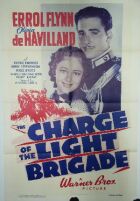 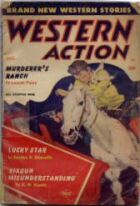




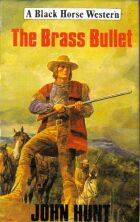
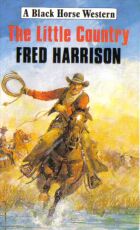
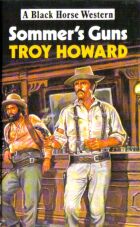



|
 Lil makes her mark.
Lil makes her mark.
 More Danners up trail.
More Danners up trail.
 Number one. Number one.
 Plus one for luck. Plus one for luck.
|
An assortment of the right tracks
HOOFPRINTS
Among generous responses to the last Black Horse Extra, which had a record number of visitors, came a recommendation from Grumpy Old Bookman
whose blog is listed by the Guardian newspaper in Britain as "one of the
top ten literary blogs". GOB exhorted his followers to nip over to the Extra
and said, "I quite like the idea of a character called Misfit Lil."
Others said: "Keep Lil's libido raging! Love that name by the way. Will look
for a title in the local library"; "The genesis of Misfit Lil was totally
absorbing and I look forward to meeting Miss Lilian Goodnight as soon as
possible"; and "Thanks for the latest news. I found the excerpts from the
Misfit Lil stories very entertaining." But one reader pointed out, "Your
lead article doesn't explain Lil's unusual handle." Author Chap O'Keefe replies,
"Miss Lilian is the scallywag daughter of a rich but vexed cattle-rancher
who'd like her to be refined, educated. After her expulsion from a high-toned
seminary for young ladies in Boston, talk of Miss Lilian's escapades further
blackens her reputation and she's called Misfit Lilian. That gets abbreviated, as nicknames do, and so we come to Misfit Lil."

Paddy Gallagher (aka Greg Mitchell) says, "While
stationed in Japan for three years I picked up some good books on the
Old West and a couple of good ones on Frederic Remington's work.
I learned a lot just looking at the detail in Remington's paintings and
shetches. The old trick of carrying the rifle in a leather loop attached
to the saddle horn has never been translated into Hollywood as far as
I know, but it is a much better way than slinging it on one side of the
horse where it can be a nuisance to the horse or the rider. This method
was used also by the Canadian Mounties and sometimes by the US Cavalry
but somehow did not survive the transition to Hollywood. Just another bit
of trivia . . . . One of Remington's paintings of a pack train has me puzzled
though. A man on a mule in the foreground has both reins on the same side
of his mule's neck. The artist would not make such a glaring mistake. He
had a great eye for detail. I have never been able to figure that one out.
My brother Mike is an artist as well as a horseman. He suggested the paint
against the mule's neck might have faded and did not reproduce properly
in the print.Who knows? I certainly won't lose any sleep over it."

Mike Linaker is as busy as ever. He told Hoofprints recently
he was writing a couple of new westerns -- working titles Down from
the High Country and Vengeance Gun -- when he wanted
a break from his latest Mack Bolan book for Gold Eagle. "I will
use the John C. Danner byline for them. . . . John Hale can
sometimes be shy of putting out too many books from a writer close together,
so when I did High Mountain Standoff I just submitted it
under John C. Danner, which I made up one afternoon when I completed the
book." Mike also reports he has arranged with Ulverscroft for new editions
of Brigham's Way, Jacob's Road, Talman's
War and Travis. "These are some of my early westerns
and it will be nice to see them in large-print editions. They'll come
out under the Richard Wyler name. I suggested this as a way of tidying
up too many pen names, and because Wyler was the name I used for my first
published books, Savage Journey and Incident at Butler's
Station." The four LP books will appear over the next sixteen
months. Three were first published in 1976 by Herbert Jenkins Ltd. Travis,
a standalone that's among Mike's personal favourites, was published by
Robert Hale Ltd in 1985. Mike said, "Ah, the good old days when life for
a writer was easier than now."

Suddenly, whole volumes of advice and promises to aspiring authors become
futile, redundant. Paul Brown and Stuart Wheatman of the
small Tonto Press give some clues that might explain why BHWs and many
other worthy books never reach the reading public."Our books aren't currently
stocked by WHSmith [the major UK bookstore chain], although we live in
hope. I imagine if we coughed up the £50,000 Smiths are demanding from
publishers to place books on their Christmas recommended list we'd have
had more luck. Unfortunately, that seems to be indicative of the incentive-based
road many retailers are heading down. Of course, our books can be ordered
from Smiths, or any 'bricks and mortar' store, but we'd much rather see
them on the shelves." The way to go, it seems, is the way BHW buyers have
to go: via online stores like Amazon UK, Tesco and Blackwells. Snag there
is, most of these sellers must add high mailing charges. Some also demand a fee for "sourcing"
the book you want, even when they list it on their website!

David Whitehead
has been a BHW writer from year one and is a stalwart BH Extra supporter,
contributing fact-packed articles like this edition's feature on Lauran
Paine. He is also a scriptwriter for the long-running Commando
war comic books from Dundee publishers D. C. Thomson & Co., where the
editor welcomes his "flair
and ingenuity". On the
western front, he reports his new Ben Bridges novel Draw Down
the Lightning is on its way. "The hero, Carter O'Brien,
featured in my first BHW all those years ago, and I've enjoyed putting him
through his paces ever since. He's my favourite character." Publisher John
Hale says the new novel -- Dave's milestone fiftieth -- was a pleasant surprise
and a splendid story. Dave adds, "As always, I've tried to come up with an
unusual theme. This one suggested itself about ten years ago, while I was
watching a programme about adopted children and their quests to locate birth
parents. The new book doesn't have anything to do with that, however! I'm
also continuing to plot Send for Morgan Starr
and Open Season, which I
hope to write as Glenn Lockwood, and am about 50 pages into Kane's
Quest -- third book in the Apacheria series by Carter
West."

Clint Eastwood has been honoured by the Motion Picture &
Television Fund with a golden boot for his contributions to the
western genre in film and television. The organization, founded in
1921, provides health care and other services for those in the Hollywood
community. Eastwood, who starred in such iconic westerns as The
Good, the Bad and the Ugly and For A Few Dollars More
and won a best-director Oscar for Unforgiven in 1992, was
presented with the Founder's Award during the group's 24th annual Golden
Boot Awards held in Beverly Hills. The ceremony recognizes actors, stunt
people, producers and directors who have furthered the tradition of the
western. The Founder's Award has been given only eight times. Eastwood
(76) is the second director to receive it after John Ford.

Gillian F. Taylor tells Hoofprints her new BHW, Two-Gun Trouble,
took a while to get written. "I had the idea for the main characters and
setting but wasn't happy with the first plot outline. I put it aside and
came back to it a couple of years later. By then, I'd visited Colorado, where
it's set, while staying with Ron McDonald (aka Lee Pierce)
and his wife. I had a wonderful time on my visit, travelling from Arizona
desert to Silverton in the snowy mountains. Most of the places mentioned
in the book are real, apart from the principal setting of Motherlode, which
is fictional, though set in a real location. The main character, Jonah Durrell, is a handsome manhunter. He first appeared as a secondary character in Navajo Rock. I liked him so much that I developed him more and gave him a starring role in his own book. I
expect he'll appear in more titles in the future -- but don't hold your breath
waiting for them to appear." Keen BHWers may have noted Gillian gave more
details of her new title and her American trip in the October update of Black
Horse Express.

|

Authentic Remington.

Stand and deliver.

Given the boot.
|
|
Gravel-voiced actor Sam Elliott reports the TNT
movie channel is moving away from westerns. "I’ve had conversations with
them. They’re not in the western game right now." He told the Pittsburgh
Post-Gazette some people tended to look down their noses at the genre as
shown on film, but he was always coming back to it. "I’m sure not going to
give up on them." Elliott's first credited film role was in Butch Cassidy and the Sundance Kid
(1969), produced during the waning days of the studio system when he was
under contract to 20th Century Fox. But a television role, the TNT film Conagher (1991), based on the novel by Louis L’Amour,
put him on the trail to cowboy-hero status. He optioned the book and co-produced
the film, taking a fresh approach to prevailing methods. "Everybody looked
like they’d just gotten out of a makeup chair . . . . We were determined
to make Conagher as real as possible."
|

Sam got real.
|

Cut! Hardy shocker.
|
A horror-movie buff tells us the theme of Jack the
Ripper in the Wild West, as presented in Lance Howard's recent
BHW Ripper Pass, is not new. Back in 1974, one Larry
G. Spangler shot Jack the Ripper Goes West (aka A
Knife for the Ladies)
in Old Tucson, Arizona. In the movie, as might be predicted, a mutilating
serial killer haunts the small South-west town of Mescal . . . most victims
have, of course, been prostitutes . . . a sweat-stained
Sheriff Jarrod (Jack Elam)
can't handle the job, so Detective Burns (Jeff Cooper)
is called in from St Louis. The slasher-western was recently brought up
from the vaults for re-release on a four-movie DVD budget pack. Will its
viewers be tempted into reading BHWs? For that matter, will the serious
Ripperologists? Howard has confidently dismissed crime writer and and forensic
scientist Patricia Cornwell's bestselling Case Solved
book on the Ripper as "specious", which cannot be reckoned to win BHWs many
new friends in that quarter!
|
|
|
The legacy of favourite singing cowboy Gene Autry lives on eight
years after his death, aged 91. Autry sought to preserve history and
his dream is realized by the venture he called "a museum to exhibit and
interpret the heritage of the West and show how it has influenced America
and the world". The Museum of the American West is located in Griffith
Park across from the Los Angeles Zoo. It's a perfect place to lose yourself
for a day, immersed in memorabilia. Inside are priceless treasures from
the Lewis and Clark expedition, Annie Oakley's presentation
rifles, and even Clint Eastwood's hat and coat from the movie Unforgiven.
Public relations director Jay Aldrich, who has been with the
museum since it opened in 1988, says, "The exhibits tell the real story
of the Old West and the mythical one. It's home to thousands of artifacts
going back more than 300 years from cowboys, American Indians, immigrants,
outlaws, fur traders, frontiersmen, adventurers and the whole cast of
characters who followed their dreams and populated the frontier west
of the Mississippi."
|
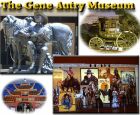
Cast of thousands.
|

A line for the ladies.
|
Way back in 1972, bestselling novelist Dean Koontz noted that women
are outstanding writers of westerns. "Women often have a talent for research
and a feel for historical periods," he said. For many years, the late Irene
Ord, formerly a romance author, penned BHWs under several male pseudonyms
-- a story that was told by the Extra's editor in Black Horse Express before
his membership of the BHW Yahoo! group was removed by Lance Howard.
Today, the Hale line has not only Gillian F. Taylor, but the women
who write first-class western novels as Eugene Clifton, Layne
Kenric, Steven Gray, T. M. Dolan, Terry Murphy
and Ty Kirwan. Black Horse Extra is always delighted to hear from
readers and writers -- guys an' gals -- of Black Horse Westerns.
Please
send your observations and reports to feedback@blackhorsewesterns.com.
|
|


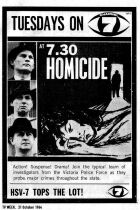
|
A fresh appreciation of a BHW giant
RINGO, FASTEST PEN IN THE WEST
The rider in the faded pink shirt, plastered to his upper body with
sweat and many miles of trail dust, wasn't expecting the ambush so soon.
He figured they
would wait until he entered the tangle of red-rock canyons, a mile or so
to the east. But, here he was, still negotiating the twisting trail up
to the high country from the pass when a rifle blasted from the needle
rocks above and to his right. . . .
Find Madigan!
Hank J. Kirby
"THEY
said my speed was next to none," Lorne Greene intoned in a pop song way back
when westerns ruled on television and radio. But "hour on hour I watched
in awe -- no human being could match the draw of Ringo."
In the BHW
world, speedy Australian writer Keith Hetherington could be a top claimant
for Ringo's gun rep, writing new novels by the month under his four pen-names:
Jake Douglas, Clayton Nash, Tyler Hatch and Hank J. Kirby.
In a message
to a less productive BHW Keith (Keith "Chap O'Keefe" Chapman), Keith Hetherington
suggested jokingly, to end any ID confusion, "Might start signing off
with 'Keith Ringo'. At school I used to get called Heather because of my
long name. After a few -- no, many! -- fights I got it down to Hetho. Then
someone started calling me Rington and eventually it ended up as Ringo long
before I had any notions of writing westerns."
Should Ringo pop up in a byline on a BHW, we'll know the prolific and popular author has added another horse to his string!
In October, Keith won our awe with Shadow Justice by Clayton Nash. In December it will be the turn of Hank J. Kirby with Find Madigan! In January, Jake Douglas will weigh in with the post-Civil War yarn North from Amarillo and Tyler Hatch with Durango Gunhawk.
"Must add
a bit about the Hatch book," Keith says. "I really laboured on that one --
trapped myself by leaving too much explanation too late and having to rewrite
virtually two-thirds of the book. I wondered what [publisher] John Hale would
think, and forgive me if I quote him with a slight puffing of a chest a bit
wheezy for anything more:
" 'Durango Gunhawk is a rip-roaring western in the best classic tradition.'
"The acceptance was rewarding as I felt I'd probably made mistakes, having taken so long and changed so much around. Well, you never really know. . . ."
Keith confesses a hatred for rewrites. "I don't mind editing
on the word processors we have now, but total rewrites give me the
irrits. I work from an outline, too, although I don't always stick
to it. Sometimes a character seems to speak of his own accord and
I get a sudden notion to shoot off at a tangent and try it, see how
it fits in. Works many times. But when I worked for the TV programme
makers Crawford, writing episodes of Homicide, Matlock
Police and Division 4, it was a set routine."
Homicide began late in 1964 in Melbourne. It became
for eight years Australia's most popular show and established the Crawford
company as the largest drama production house. Keith explained how it
worked.
"First came the storyline, followed by special meeting for all the bods
who thought they knew better than the writer to sort it out, then a
mandatory scene breakdown which, when approved, the script was written
from. A final meeting was held with the editor and sometimes the director
chosen to film the episode.
"All good stuff, mostly because they were knowledgeable about what
was right for TV and what not. I'd always used a story outline for westerns
anyway, so I didn't have much trouble fitting in to the TV system --
luckily! I say that because it was, and still is, I guess, an industry
where crises arise overnight, if not more frequently.
"Schedules are put forward or disrupted in some other way, and you
might've just about forgotten the script three back up the line when
a phone call comes about length or inability to film in such and such
a location. You have to come up with a substitute scene that won't throw
everything out of kilter. Still, it makes for an interesting time, and
it was probably the most enjoyable period of my writing career -- five
and a half years of it and Hector Crawford actually recognized that writers
were different to your usual employees. We worked from home, went in
for the script meetings and so on, then returned to the suburbs, which
was the beach in my case. Very good, plus a hefty bonus for bringing in
a script on time or earlier."
Thus Keith honed his talents as a "speed writer", which had already
been developed in working for the voracious Cleveland publishing firm of
Sydney.
One of the many keen readers of his westerns was David Whitehead in
England. Dave says, "I remember Keith's earlier incarnations as Kirk Hamilton
and Brett Waring, two of the most popular writers in the Cleveland stable."
At BH Extra's request, Dave promised to look for a long-lost interview
with Keith which he wrote up in 1994, shortly before Keith moved on to
writing BHWs. "I searched through my loft yesterday afternoon, without
success. Then I thought I'd check a few boxes still tucked away in the
garage and to my great pleasure I found the article, which I have now
retyped. I hope you can find a good home for it."
We certainly can, and most gratefully.
The Interview
DW: Can you tell us something about your early years?
KH: I can lay claim to have started “writing” when I was about
12 years old and World War II was raging. Always an action fan, I lapped
up war films and began to write my own war stories, illustrating little home-made
booklets with pictures cut from Life magazine and a wartime
one called Victory. I played around with these on and off,
but I was working during the day and studying chemistry at night. I was
about 18 when I finally read a book of western short stories I’d bought.
The lead story was called Jailbreak Justice. I can’t recall
the author. But I felt it was a pretty poor effort, and I could do much
better. So I wrote a western short story -- my first, apart from a couple
of cowboy booklets I’d made up -- and sent it to a publisher who was later
bought out by Cleveland Publishing. A couple of months passed before they
accepted it. Then they paid me the princely sum of £6-15-0 and asked for
more. That was how I started. Eventually the stories moved up through 20,000-word
novelettes, then 48,000-worders. They dropped back through 42,000 then settled
at the later 40,000. As I was being paid so much per thousand words, earnings
fluctuated wildly.
I wrote westerns full-time between 1957 and 1961 when -- by this
time married to Rita and with my first son born -- I went into journalism
with the Queensland Department of Health, where I worked until 1970
as a departmental editor, writing fiction and articles at night and whenever
spare time allowed. I had a boys’ adventure book published in 1966, The
Scuba Buccaneers, as by James Keith, and two hardback thrillers,
The Naked Nemisis and Hammerhead Reef under
the name Keith Conway, both published by Robert Hale.
I moved to Victoria and worked for Crawford Productions from 1970 to
1975. These, I would say, were my happiest years. When the company
almost went broke due to American TV shows being dumped on the Australian
market at giveaway prices, I returned to writing westerns full-time for
Cleveland, with a little freelance television work in between. Since
I was also free to write anything else apart from westerns, I did a book
on metal detecting which is still selling, some books-of-the-film, and
had a couple more hardback thrillers published, again by Robert Hale -- A
Dragon out of the South and The Judas Coast, both under
my own name.
DW: Why do you suppose you were particularly attracted to the western
genre? And who were your influences?
KH: I’d always enjoyed westerns. Zane Grey was a favourite. Three especially
good books were Riders of the Purple Sage, its sequel, The
Rainbow Trail and one of his lesser-known works, Shadow on
the Trail. Luke Short was another favourite. I liked his tough
style and his characterization, plus his strong plots. In 1953, when I was
sailing to England and was right on the verge of mal de mer in the
Great Australian Bight, I read Luke Short’s High Vermillion
avidly, page after page, immersing myself in the story and the action
-- there was a terrific fist-fight, as I recall -- until I felt better.
I never did make a libation to Neptune, and I’ve always thanked old Luke
for it.
As for influences … my western background stems from reading the classics
and plenty of the Street & Smith, pulp-type stuff, as well as the
better American authors and reference works like the Time-Life series.
One thing I found a bit frustrating writing for Cleveland was that they
didn't want Indians. You wouldn’t believe how hard it was to get them to
accept a story in which the hero had to call in the talents of Indian
scouts from a nearby reservation to track down the villain. It was a pity,
because a lot of authentic lore was just begging to be used.
DW: How did your two Cleveland pen-names come about?
KH: Kirk Hamilton was thought up by Cleveland, probably because the
initials matched mine and they had just contracted me to write a western
per month. Previously, I'd used the pen-name Clint McCall, but it appeared
only on 20,000-worders they put out in the early to mid-1950s. Later, they
used it for one of their other writers. I was doing 24 to 27 westerns novels
a year from the early 1970s to 1990, when Cleveland decided they had such
a backlog of contract writers' work they no longer required any more.
They reckoned putting a hold on for a couple of years, but it went on for
quite a bit longer.
As you say, I also wrote as Brett Waring. I didn’t attempt to change
my style -- you read a Brett Waring, you read a Kirk Hamilton and vice versa.
Cleveland would never tell me when they were going to put out a title under
the Brett Waring byline, so I simply wrote the stories and sent them in and
left it up to them which name they put on the cover. They fouled up though.
I used to write a Brett Waring series about Wells Fargo with the hero Clay
Nash appearing in each yarn as an undercover agent for the stage-line. They
were mostly routine stories but sold well. Anyway, in their wisdom -- or
lack thereof -- Cleveland put a couple of Clay Nash stories out under the
Kirk Hamilton name, which gave the game away to anyone astute enough to
notice. A bit sloppy, to say the least.
DW: Talking of series, your best-known series during this period
was Bannerman the Enforcer, in which a task-force answerable only to
the Governor of Texas is sent on all kinds of do-or-die missions. The
series was extremely popular and ran to 48 titles, then suddenly stopped.
Why?
KH: At one time, the Enforcer was published in Scandinavia and, I think,
Germany, under the title Johnny Colt. Four also appeared in paperback
in America. The series sold very well in Australia, but
Les Atkins, owner-publisher of Cleveland, phoned one day and said he
was axing it. He admitted it was still selling well, but he was getting
tired of it.
DW: By your own estimate, you’ve written between 400 and 500 westerns.
Plots must have been difficult to dream up, but I imagine finding different
titles must have been even harder.
KH: Well, one of the reasons I haven’t got a complete bibliography
is because probably only one of my titles in every ten was used. Cleveland
had hundreds of titles -- usually some vapid western saying like Reach
for It! or Drag, Mister! But during the last few
years I wrote for them, several of my own titles slipped through. I think
they must have been running short.
Actually, they published in quite a haphazard way. Sometimes it would
be only a couple of months before a title appeared. At other times it
could be two years. I sold them Hatch! in 1986, and it
didn’t appear on the shelves until 1991.
I might sound critical of Cleveland, but I’ve no real complaints,
apart from the low payment. I guess any author has some sort of bitch
about his publisher. I enjoyed working for them, but did eventually became
a bit bored with westerns. That's why I turned to a couple of thrillers.
Mind you, by the time I’d finished them, I couldn’t wait to get back
to westerns, because I had so many fresh ideas to put down on paper!
DW: You’ve written more than westerns and thrillers, of course.
KH: Sure. I also wrote ten books on soldiers of fortune for Cleveland,
using the name James Keith. This was when they were looking for a new direction
and were also trying romance. Warhawks sold well, but not well enough
to run to a second series.
Apart from Warhawks, I’ve written and published dozens of articles
on guns, hunting, survival, metal detecting, treasure hunting,
skin diving, etcetera, as well as three short stories for Penthouse
Australia and one or two competition prizes.
The name Jake Douglas first appeared -- twice -- in the Hale catalogue
for July-December 1995, alongside regular BHW names of the time that included
Ben Bridges, Lewis B. Patten, Ernest Haycox, Cole Rickard and Chap O'Keefe.
Today, Keith Hetherington has out-written them all.
"I've books from Hale
piled everywhere in my office."
And the future holds more, including the new Kirby entry, Find
Madigan!
"This could well be the last in the Madigan series," Keith says, "though
in the best tradition of such things I've left an open ending -- a loophole
-- for his return in case I get the urge to return to it. I didn't really
want to get rid of him but felt I'd gone about as far as I could without
repetition. Anyway, he'd had such a series of batterings in the previous
books, I reckoned he'd earned some kind of reward and R&R."
Keith looks forward to every new edition of BH Extra. "It's always
interesting and entertaining. Thanks for keeping my name and work in front
of the readers."
And Keith's part of the contract is that he'll keep those first-class
westerns coming as long as he's able. "I've just finished Kid Lobo
today and the manuscript goes off tomorrow. . . ."
|
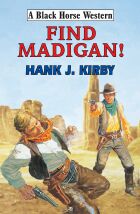



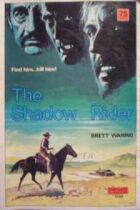

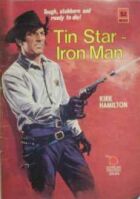




|

|
NEW BLACK HORSE
WESTERN NOVELS
(Published by Robert Hale Ltd, London)
On the Wapiti Range
|
Owen G. Irons
|
0
7090 7979 6
|
Misfit Lil Gets Even
|
Chap O'Keefe
|
0
7090 8015 8
|
Arizona Showdown
|
Corba Sunman
|
0
7090 8034 4
|
Killing in Cartuna
|
George J. Prescott |
0
7090 8175 8
|
Justice for Crockett
|
Dale Graham
|
0
7090 8067 0
|
| Homesteader's War
|
Tom Parry
|
0
7090 8112 X
|
The Legend and the Man
|
Ben Nicholas
|
0
7090 8145 6
|
Hard Ride to Largo
|
Jack Holt
|
0
7090 8174 X
|
A Town Called Limbo
|
Dempsey Clay
|
0
7090 8180 4
|
The Night Riders
|
Matt Laidlaw
|
0
7090 8182 0
|
Massacre in Madison
|
Daniel Rockfern
|
0
7090 7648 7
|
Nightmare Pass
|
Lance Howard
|
0
7090 7964 8
|
Colt Heat
|
Matt James
|
0
7090 8110 3
|
Return to Black Rock
|
Scott Connor
|
0
7090 8170 7
|
Bitter Vengeance
|
Matt Chartair
|
0
7090 8191 X
|
Hal Grant's War
|
Elliot James
|
0
7090 8192 8
|
Wyoming Showdown
|
Jack Edwardes
|
0
7090 8195 2
|
Find Madigan!
|
Hank J. Kirby
|
0
7090 8196 0
|
Marshal of Storytown
|
Clint Ryker
|
0
7090 8202 9
|
Bad Moon over Devil's Ridge
|
I. J. Parnham |
0
7090 8203 7
|
Trouble at Taos
|
Jackson Davis
|
0 7090 8204 0
|
High Stakes at Casa Grande
|
T. M. Dolan
|
0 7090 8125 1
|
Durango Gunhawk
|
Tyler Hatch
|
0 7090 8274 3
|
The Trail to Yuma
|
Terrell L. Bowers
|
0 7090 8226 2
|
Mogollon Rim Riders
|
Walt Masterson
|
0 7090 8227 9
|
Destination Boot Hill
|
Peter Mallet
|
0 7090 8230 9
|
Dakota Skies
|
Logan Winters
|
0 7090 8237 8
|
Desert Crossing
|
H. H. Cody
|
0 7090 8236 1
|
North from Amarillo
|
Jake Douglas
|
0 7090 8234 7
|
Hard Men Riding
|
Elliot Conway
|
0 7090 8233 0
|
|

|
|
Ten new titles are
issued every month as BHWs -- tough, traditional or,
sometimes, off-trail. The brand caters for all tastes.
Black
Horse Westerns can be requested at public libraries, ordered at good
bookstores, or bought from online
retailers such as Tesco, Amazon UK, WH Smith and Blackwells.
Trade inquiries
to: Combined Book Services,
Units I/K, Paddock Wood Distribution
Centre,
Paddock Wood, Tonbridge, Kent TN12 6UU.
Tel: (+44) 01892 837 171 Fax: (+44)
01892 837 272
Email: orders@combook.co.uk
|
|
|
|
|
|